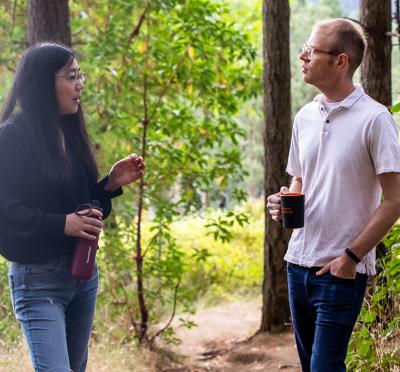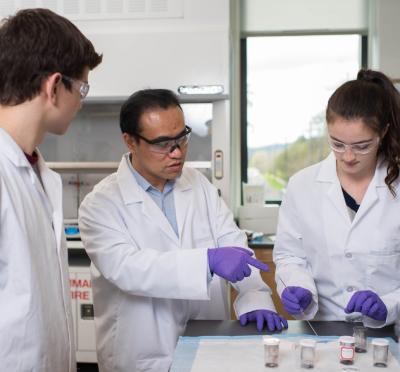
Like to take pictures when you travel? So does Donald R. Pettit, a 23-year veteran of the space program. But the scenic views he captures aren’t the same as the typical tourist’s.
Pettit’s passion for photography began in the sixth grade. Growing up in Silverton, Oregon, he developed and printed his pictures in a small darkroom that doubled as the family’s laundry room. His interest — most likely sparked by his mother, herself a photographer — has grown throughout his life, from amateur astronomer to NASA astronaut.
After earning a couple of degrees in chemical engineering — a bachelor of science from Oregon State University in 1978 and a doctorate from the University of Arizona in 1983 — it occurred to Pettit that he had acquired the basic qualifications needed to become an astronaut. And NASA was recruiting.
First, he took a job as a staff scientist at Los Alamos National Laboratory in Los Alamos, New Mexico. His projects there included working on fluid flow and materials processing experiments onboard NASA’s KC-135 zero-gravity airplane. He was also part of the Synthesis Group, a committee assembled in 1990 to begin tackling the technology requirements to send humans back to the moon and then on to Mars. In 1993, he was asked to join the Space Station Freedom redesign team, whose principal outcome was a cooperative venture with Russia that became the blueprint for today’s International Space Station. These experiences, combined with a lot of tenacity, paved his way into the space program.
has accrued 370 days in space and 13 hours of spacewalks.
Since joining NASA in 1996, Donald R. Pettit (’78 B.S, Chemical Engineering) has accrued 370 days in space and 13 hours of spacewalks.
Since joining NASA in 1996, Pettit has accrued 370 days in space and 13 hours of what the space agency calls “extravehicular activity,” or spacewalks. He’s lived aboard the International Space Station for two extended periods: for 5 1/2 months in 2002 during Expedition 6 as a member of the STS-126 crew, and for 6 1/2 months in 2011–12 during Expedition 30/31.
Astronauts are assigned countless duties on the space station, from conducting research experiments to performing facility maintenance and repair. During his off-duty time, Pettit produced a series of educational programs for kids about how materials and objects behave in a weightless environment. These video vignettes, called “Science off the Sphere,” can be seen on YouTube.
Pettit also put his photographic talents to work, capturing the views from above. He and his crewmates took about 600,000 photographs over three missions. A collection of his favorite photographs has been published in a book called “Spaceborne.”
“These images are also art,” Pettit said. “They illustrate to people what space is like, for those who don’t get a chance to fly in space.”
Photographing Earth and the Atmosphere
The International Space Station is situated 240 miles above Earth and orbits the planet, covering 24,000 miles every 90 minutes. Pettit said the elements that produce a good photograph on Earth — focus, exposure, and composition — still apply in space, but the execution requires a new skill set.
“In some aspects, I’m thinking as a photographer who just happens to be an astronaut,” he said. “And sometimes, I’m an astronaut who just happens to be a photographer.”
Astronauts receive extensive training on how to take pictures in space; the challenge is getting photos that look like what we see with the naked eye, in terms of color and vibrancy. The space station travels at a pace of 5 miles per second. Planned and unplanned shots require preparation. You only have a few seconds to grab the shot — there’s no time to change lenses, Pettit explained. Several crew members may photograph the same target with different cameras, from slightly different angles.
Taking pictures in the exoatmosphere is also challenging. The brightness ranges are wider than on Earth, creating stark contrasts between sunlight and darkness. To compensate, photos are taken manually. Pettit would snap multiple images in rapid succession, sequentially adjusting the exposure times. Back on Earth, he would combine photos in post-processing to show more detail and motion than could be seen in a single exposure.
The best place to shoot photographs on the space station is from the cupola module. The observatory contains seven large windows designed for viewing Earth, conducting experiments, and observing the space station and shuttle docking areas. Three or four cameras are always turned on and pointed toward a target. People tend to gather in the cupola, so photographers must work within the confines of a tight space with inherent obstacles that interfere with visibility and photo quality.
NIGHTSCAPES
“My favorite photography environment is nighttime Earth from orbit, whether it’s cities at night, or capturing an oblique view of Earth where you can see the atmosphere on edge with an aurora and starfields,” Pettit said.

station span the length of about half a continent.
This image captures Spain, Portugal,
North Africa, and Gibraltar.
His night photos feature stunning views of cities, lightning streaks across dark skies, auroras, and planetary phenomena executed with meticulous precision using time-lapse, long exposure, and split-second timing.
Pettit pioneered some of the techniques that have made these sharp nighttime images of cities possible. During his first mission, in 2002–03, digital photography was in its infancy. When longer exposures were needed to capture night shots, the handheld cameras produced hazy pictures. To address this issue while also compensating for the movement of the space station relative to the Earth’s surface, Pettit constructed a makeshift barn door tracker using spare parts gathered from the space station.
“In the photos of cities at night, I see three related features,” Pettit said. “The way human beings sprinkle their light bulbs around is a fascinating statement on how we, as human beings, define our urban areas. It’s a juxtaposition between geography, the technology they choose, and culture.”
Taking it a step further, Pettit sees cultural implications in the patterns of lights as seen from space.
“Most cities in the United States are laid out on north-south, east-west grids — so it looks engineered. Cities in Europe are a spider web, a mishmash of circular arches running in all directions. Some cities look like something that was initially a cow trail that was made into a road, then a highway, then a superhighway,” he said. “You can see an evolution of what happened there.”
Pettit’s book makes further observations about cities at night: South American cities are diffusely illuminated through the entire urban area. India is a misty expanse dotted with smoky village fires. Cities in Asia glow blue-green — the signature of mercury-vapor lights. The Amazon Basin is velvety black — one of the last great refuges for nature’s dark. And Las Vegas may very well be the brightest spot on Earth.
Star Trails

shots — up to 30 minutes. The Earth (at the bottom)
and the stars (at the top) are streaking because of
the orbital motion; the cities are streaking from the
combination of orbital motion and the Earth’s rotation.
The white spots on Earth are flashing thunderstorms.
Amateur photographers have long been able to use time-lapse photography to produce beautiful star-trail images on Earth, so Pettit decided to apply the same technique in space. He discovered the physics behind the motions are different.
“My star trail images are made by setting a time exposure of about 15 to 30 minutes. However, with modern digital cameras, 30 seconds is about the longest exposure possible, due to electronic detector noise effectively snowing out the image. To achieve the longer exposures, I do what many amateur astronomers do. I take multiple 30-second exposures, then stack them using imaging software, thus producing the longer exposure,” Pettit said.
Star trails fill the emptiness of space, while cities and lightning storms create colorful patterns on the Earth below. One lightning flash appears as a lighted dot, then reappears with time-lapse across the entire photo as the space station continues on its orbital path.
AURORAS

greens, reds, and blues. The colors correspond to different
quantum transitions in excited oxygen and nitrogen atoms.
Pettit and his space mates have actually flown into these
celestial light shows. “It’s like being shrunk down and put
inside of a neon sign,” he said.
Auroras, also known as the northern and southern lights, are caused by charged particles streaming out of the sun that eventually hit Earth’s atmosphere. There, the particles interact with oxygen and nitrogen molecules to produce colorful waves of light dancing across the sky near the poles.
“Aurora is just amazingly beautiful. It’s this glowing upper part of the atmosphere that crawls around like amoebas in the sky,” Pettit said.
But, Pettit said, capturing the awesomeness of an aurora is tricky.
“The green part of the aurora is about three f-stop settings brighter than the red part. If you expose for the greens, you won’t see the reds. If you expose for the reds, the greens will be saturated. We see these same things on Earth, compromising between what you can and can’t see,” Pettit said in an interview with SmugMug, a photo hosting and sharing website.
Infrared and Monochrome
Pettit modified a handheld camera to allow near-infrared photography to collect imagery of red emissions of auroras while on Expedition 30.

the plume of an active volcano in Patagonia, Argentina.
“Taking infrared photos combined with visible images gives you two datasets to look at and draw some technical conclusions,” Pettit said. “You can observe lush farmlands and forests, and see other areas that aren’t doing so well.”
In infrared photography, lush green plants appear as bright orange-red. Rocky crags and other barren geologic structures appear as dark green to blue-gray. Turbulent oceanic currents become visible as whitish veils, and coral reefs glow a tie-dyed yellow-green.
Pettit has also snapped some stunning black and white photos — images not typically shot by astronauts. When color is stripped away, the eye begins to focus on different details.
“I really like to link science and art together,” Pettit said, “especially if making observations in nature. They can be scientific, but also be artful. I feel it’s important not only to observe, understand, and enjoy the technical aspects, but also to sit back and enjoy the art form of the data you just collected.”
For more on “Spaceborne,” visit: space-borne.com.
Learn more about Donald Pettit’s life and photography while aboard the International Space Station. See “Making the invisible visible” by Christoph Malin: vimeo.com/61083440.
Photo credit: Donald R. Pettit



